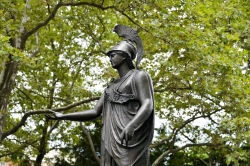Athens Square
View all monuments in NYC Parks, as well as temporary public art installations on our NYC Public Art Map and Guide.
Athena
| Artist: | Spiro Goggakis |
| Dedicated: | March 28, 1998 |
| Location: | 30th Avenue between 29th & 30th Streets |
Artwork History
The Park at Athens Square is named for the capital of modern Greece and the center of ancient Greek civilization. From 594 to 404 BC, literature, science, philosophy, and the arts flourished in Athens. The birthplace of democracy had its golden age during the rule of statesman Pericles (c. 495-429 BC), who made sweeping political reforms and actively supported the arts. Pericles is credited with the Athenian oath of fealty, which has been invoked by New York City mayors Fiorello H. LaGuardia and Rudolph W. Giuliani (in 1934 and 1998 respectively). Oath-takers pledge to “transmit this city not only less, but far greater and more beautiful than it was transmitted to us.” In this spirit Astoria’s citizens transformed a playground into The Park at Athens Square.
In 1963, this .9-acre site was acquired for a playground to be operated jointly by Parks and the Board of Education. A new school and playground were built, and P.S. 17 welcomed its first pupils in 1967. When the park opened four years later, it featured a basketball-volleyball court, handball court, sandbox, climbing equipment, game and picnic tables, and a public restroom. P.S. 17 is named the Henry David Thoreau School, for the American naturalist and philosopher (1812-62).
A $1 million capital reconstruction of the park was funded by the city in 1990. The idea to reuse the play space as a neighborhood gathering place originated with members of Astoria’s sizable Greek-American population, many of whom had immigrated to New York after the Greek civil war of 1945-49 and the relaxation of restrictive American immigration laws in 1962. Athens Square, Inc., a community-based group, formed to promote the park renovation, and Stamatios P. Lykos was engaged as the architect. The Park at Athens Square would encompass three zones: a central court with amphitheater and sculpture, a recreational space, and a seating area along the perimeter. The group said its intention was to create “a little bit of Athens in Astoria.”
Restoration and landscaping activity in 1993 focused on new trees and plantings, benches and tables, a playground, and a basketball court. A bronze statue of the philosopher Socrates (469-399 BC) mounted on a granite base, was unveiled in the park. Designed by artist Anthony Frudakis, the statue depicts Socrates in a seated position, gesturing as if engaged in dialogue. In 1996, three fluted Doric columns supporting a curved entablature, all of granite, were installed adjacent to the amphitheater. This composition echoes that of the Tholos of Athena Pronaia in Delphi (c. 390-380 BC). The Park at Athens Square has raised approximately $360,000 for Socrates and the columns. The installation of fencing, gates, and safety surfacing, as well as concrete curb and block repairs, were conducted through a requirements contract funded by the City Council in 1997.
Demetris Avramopoulos, Mayor of Athens, presented a replica of the Piraeus Athena (c. 350 BC) for installation in the park as a gift to the City of New York on March 28, 1998. Sculptors Stavros Georgopoulos and Spiro Goggakis fashioned this bronze copy based on the ancient statue of Athena, the goddess of wisdom, patroness of the arts, and protectress of Athens. A statue of Minerva, the Roman counterpart to Athena, is the centerpiece of the James Gordon Bennett Memorial (1895/1940) in Herald Square, Manhattan.
This area of Queens was formerly known by the Algonquian name of Sunswick, derived from the word Sunkisq, meaning “woman chief.” In 1839 developer Stephen A. Halsey incorporated the village of Astoria, named in honor of fur trader and landowner John Jacob Astor (1763-1848). Within a few decades, the area was home to a number of wealthy merchants, a substantial German-American community, and the Steinway piano company. Over the course of the 20th century, construction of homes and apartments, the growth of new industries, and the arrival of numerous immigrants transformed Astoria into the thriving and diverse neighborhood it is today.
Artwork Details
| Description: | Standing figure (heroic scale) on pedestal |
| Architect: | Stamatios P. Lykos, AIA, ASLA |
| Materials: | Figure--bronze; pedestal--green granite |
| Dimensions: | Figure H: 7'9"; pedestal H: 4'6" L: 3'4" W: 3'4" (all approximate) |
| Foundry: | Dimitrus Gavalas, Patmou 3, Marousi, Atiki, Greece |
| Fabricator: | Stavros Georgopoulos |
| Donor: | City of Athens, Greece (sculpture); Athens Square, Inc. (installation) |
| Cast: | ca. 1998 |
Inscription
ATHENA /---/ A GIFT FROM THE PEOPLE OF / ATHENS, CAPITAL OF GREECE /---/ TO THE PEOPLE OF / THE CITY OF NEW YORK /---/ DIMITRIS L. AVRAMOPOULOS / MAYOR OF ATHENS /---/ RUDOLPH W. GIULIANI / MAYOR OF NEW YORK / MARCH 1998Please note, the NAME field includes a primary designation as well as alternate namingsoften in common or popular usage. The DEDICATED field refers to the most recent dedication, most often, butnot necessarily the original dedication date. If the monument did not have a formal dedication, the yearlisted reflects the date of installation.
For more information, please contact Art & Antiquities at (212) 360-8163.
Check out your park's Vital Signs
Clean & Safe
Green & Resilient
Empowered & Engaged Users
Share your feedback or learn more about how this park is part of a
Vital Park System














